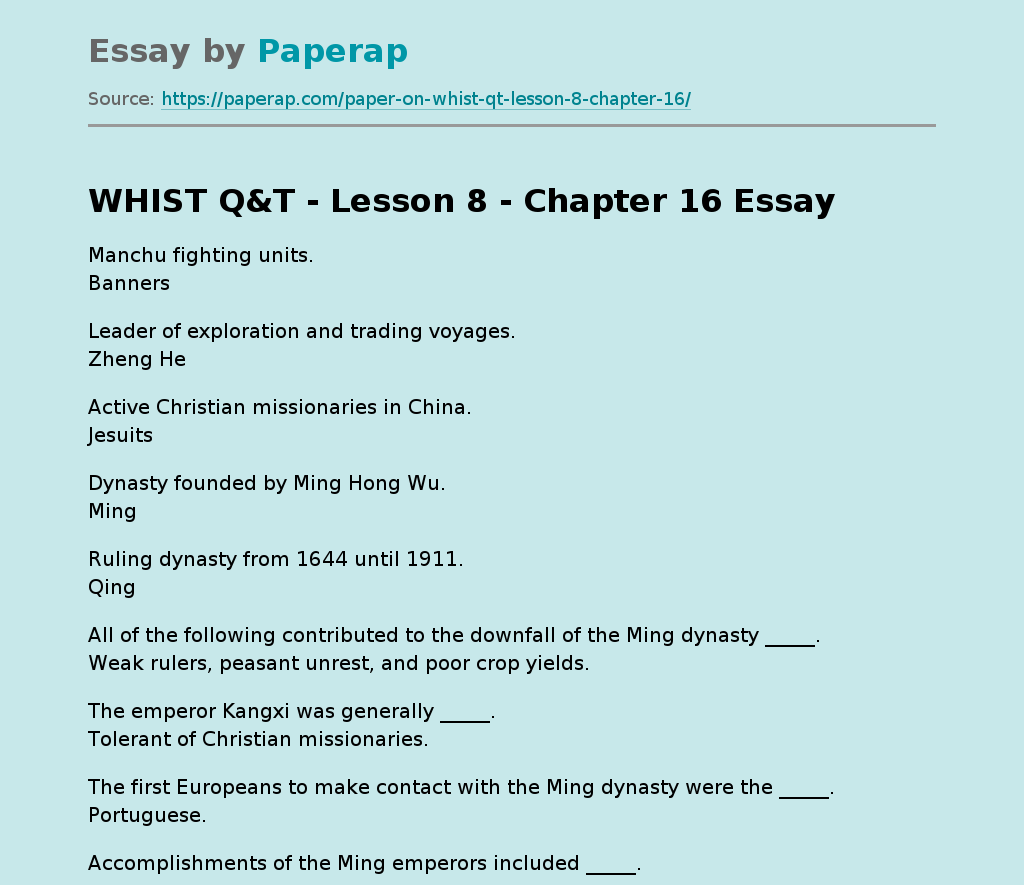WHIST Q&T - Lesson 8 - Chapter 16
Essay,
Pages 4 (839 words)
Views
24
Manchu fighting units.
Banners
Leader of exploration and trading voyages.
Zheng He
Active Christian missionaries in China.
Jesuits
Dynasty founded by Ming Hong Wu.
Ming
Ruling dynasty from 1644 until 1911.
Qing
All of the following contributed to the downfall of the Ming dynasty _____.
Weak rulers, peasant unrest, and poor crop yields.
The emperor Kangxi was generally _____.
Tolerant of Christian missionaries.
The first Europeans to make contact with the Ming dynasty were the _____.
Portuguese.
Accomplishments of the Ming emperors included _____.
Completing the Grand Canal.
Reports from early Christian missionaries.
Made Europeans more curious about China.
Private business based on profit.
Commercial capitalism
Traditional custom for Chinese women.
Footbinding
Walled compound inside Beijing.
Imperial City
Most famous of Chinese decorative arts.
Blue and white porcelain.
Group of many related families.
Clan
All of the following changes occurred in China between 1500 and 1800 _____.
An increase in population, improvements in the food supply, and growth in manufacturing and trade.
Private business-for-profit did not increase in China for all of the following reasons _____.
Government control of manufacturing and trade, heavy taxes on manufacturing, and Chinese attitudes toward trade and manufacturing.
The ideal family unit in Qing China consisted of _____.
The extended family.
Between 1500 and 1800, 85 percent of Chinese people were _____.
Farmers
The forbidden City was _____.
Closed to commoners.
Heads of noble families.
Daimyo
Territories or domains.
Hans
Political control used by the shogunates.
Hostage system
Crops grown for sale.
Cash crops
Japanese social outcasts.
Eta
Much of the prose literature of the Tokugawa Era was _____.
Lighthearted and entertaining.
Samurai served as all of the following _____.
Advisers, government officials, and castle guards.
The Japanese warrior class consisted of all of the following _____.
Shogun, ronin, and daimyo.
The first Jesuit missionary, who came to Japan in 1549, _____,
Was Francis Xavier.
Which of the following is NOT true?
Europeans were interested in buying Japanese weapons. (NOT true.)
Led the voyages of exploration during the Ming dynasty.
Zheng He
The Qing hairstyle dictated for men.
Queue
Separate Manchu military units, which became the chief Qing fighting force.
Banners
Consisted of dozens, or even hundreds, of related families.
Clan
Considered to be the first realistic social novel.
The Golden Lotus
Generally considered even today to be China’s most distinguished popular novel.
The Dream of the Red Chamber
Completed the restoration of a central Japanese authority.
Tokugawa
Warriors without masters.
Ronin
Form of entertainment that emphasized action, music, and dramatic gestures.
Kabuki
Korean dynasty that remained in power during the entire Tokugawa Era in Japan.
Yi
Who initiated the construction of the Imperial City in Beijing?
Yong Le
The overthrow of the Ming dynasty allowed _____.
Manchus to seize power and establish the Qing dynasty.
During the reign of Qianlong, _____.
The Qing dynasty showed the first signs of internal decay.
The footbinding of Chinese women was _____.
Considered a status symbol in Qing society.
_____ was the author of the Chinese novel The Dream of the Red Chamber.
Cao Xuegin
What was the Japanese name for the heads of noble families?
Daimyo
By 1590, Toyotomi Hideyoshi had _____.
Persuaded most of the daimyo to accept his authority.
Who is considered to be the greatest of all Japanese poets?
Matsuo Basho
Japanese pottery makers borrowed techniques and designs from _____ to create handsome ceramic pieces.
Korea
Because its rulers tried to keep it isolated from the rest of the world, Korea _____.
Earned the name “the Hermit Kingdom.”
Initiated the construction of the Imperial City in Beijing.
Yong Le
Led the peasant revolt that overthrew the Ming dynasty.
Li Zicheng
Rejected Britain’s request for more liberal trade policies.
Qianlong
Considered a status symbol by Qing society.
Footbinding.
Author of The Dream of the Red Chamber.
Cao Xuegin
Heads of noble Japanese families.
Daimyo
Began the restoration of a central Japanese authority.
Oda Nobunaga
Author of Five Women Who Loved Love.
Ihara Saikaku
Borrowed techniques and designs from Korea.
Japanese pottery makers.
“The Hermit Kingdom.”
Korea
Who led the Ming dynasty’s naval voyages of exploration?
Zheng He
In order to identify rebels who opposed Manchu rule, the government _____.
Ordered all Chinese males to shave their foreheads and braid their hair into a pigtail called a queue.
Perhaps the greatest emperor in Chinese history, _____, took charge of the government while still in his teens and reigned for 61 years.
Kangxi
Beyond the extended Chinese family was the _____, which consisted of dozens, or even hundreds, of related families.
Clan
The Chinese novel _____ is considered by many to be the first realistic social novel.
The Golden Lotus
Perhaps the most famous of all the arts of the Ming Era was _____.
Blue-and-white porcelain, which Europeans collected in great quantities.
Which rulers completed the restoration of central authority in Japan in the early 1600s?
Tokugawa
Under the Tokugawa class system, the eta were _____.
Outcasts whose places of residence, dress, and hairstyles were regulated by severe laws.
Fearing Kabuki could corrupt the nation’s morals, Japanese government officials _____.
Forbade women from appearing on stage, creating a new professional class of male actors.
The _____ remained in power during the entire Tokugawa Era in Japan.
Yi dynasty of Korea.
WHIST Q&T - Lesson 8 - Chapter 16. (2018, Sep 15). Retrieved from https://paperap.com/paper-on-whist-qt-lesson-8-chapter-16/
Let’s chat?
We're online 24/7

